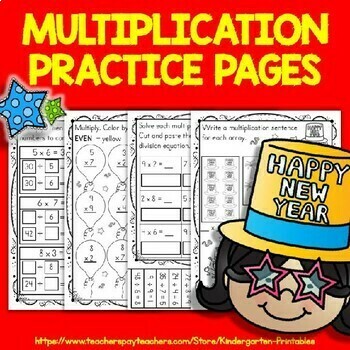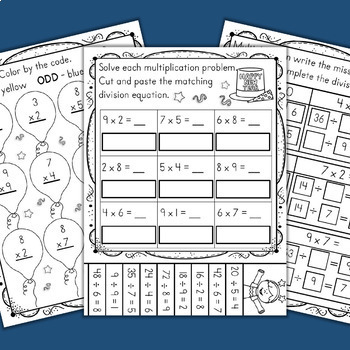New Years 2024 (Multiplication Practice Pages for Kids)
Kindergarten Printables
1.5k Followers
Grade Levels
3rd, Homeschool
Subjects
Resource Type
Standards
CCSS3.OA.A.1
CCSS3.OA.A.4
CCSS3.OA.B.5
CCSS3.OA.B.6
CCSS3.OA.C.7
Formats Included
- Zip
Pages
4 + FREE 2 PAGES
Kindergarten Printables
1.5k Followers
Description
NEW YEAR 2024 - 4 pages to practice Multiplication
Multiply. Then write the missing numbers to complete the division equations.
Multiply. Color by the code. Color the EVEN product yellow. Color the odd product blue.
Solve each multiplication problem. Cut and paste the matching division equation.
Write a multiplication sentence for each array.
Just added: December 23, 2022
Solve. Write the correct letter for each matching fact.
Cut and paste the correct picture to make each sentence true. Use the code to help you
Total Pages
4 + FREE 2 PAGES
Answer Key
N/A
Teaching Duration
N/A
Report this resource to TPT
Reported resources will be reviewed by our team. Report this resource to let us know if this resource violates TPT’s content guidelines.
Standards
to see state-specific standards (only available in the US).
CCSS3.OA.A.1
Interpret products of whole numbers, e.g., interpret 5 × 7 as the total number of objects in 5 groups of 7 objects each. For example, describe a context in which a total number of objects can be expressed as 5 × 7.
CCSS3.OA.A.4
Determine the unknown whole number in a multiplication or division equation relating three whole numbers. For example, determine the unknown number that makes the equation true in each of the equations 8 × ? = 48, 5 = __ ÷ 3, 6 × 6 = ?.
CCSS3.OA.B.5
Apply properties of operations as strategies to multiply and divide. Examples: If 6 × 4 = 24 is known, then 4 × 6 = 24 is also known. (Commutative property of multiplication.) 3 × 5 × 2 can be found by 3 × 5 = 15, then 15 × 2 = 30, or by 5 × 2 = 10, then 3 × 10 = 30. (Associative property of multiplication.) Knowing that 8 × 5 = 40 and 8 × 2 = 16, one can find 8 × 7 as 8 × (5 + 2) = (8 × 5) + (8 × 2) = 40 + 16 = 56. (Distributive property.)
CCSS3.OA.B.6
Understand division as an unknown-factor problem. For example, find 32 ÷ 8 by finding the number that makes 32 when multiplied by 8.
CCSS3.OA.C.7
Fluently multiply and divide within 100, using strategies such as the relationship between multiplication and division (e.g., knowing that 8 × 5 = 40, one knows 40 ÷ 5 = 8) or properties of operations. By the end of Grade 3, know from memory all products of two one-digit numbers.





